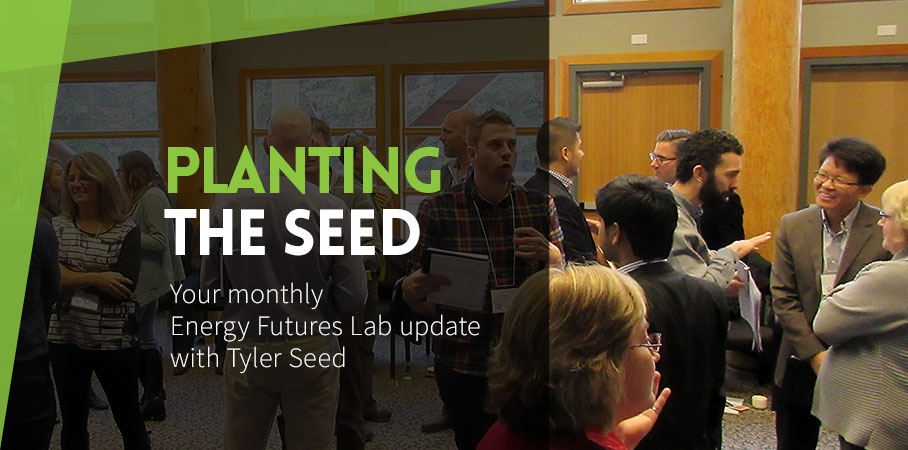
Back in February, Energy Futures Lab Director Chad Park blogged about ‘Our Unfinished Backcasting Business’. He explained how an EFL vision of Alberta’s energy future, in part defined by science-based conditions for a sustainable economy, would be essential to establishing the creative tension that will drive innovation in the lab.
How did we get to the point where the fellows could agree on a vision that is at once robust enough to provide direction to their collaborative efforts, inclusive enough for acceptance by the wide range of interests represented in the Lab, and sufficiently ambitious to inspire?
It is this ingredient – a motivating, principle-based shared vision of future – that differentiates the Energy Futures Lab (and other Sustainability Transition Labs convened by The Natural Step Canada) from comparable lab initiatives.
In February, Chad also described the lukewarm sentiment of the fellows about their initial attempt at defining this vision statement. At the time they deemed it not ambitious enough and too generic.
Fast forward to today, and while the business of backcasting is by no means “done”, the vision statement has been articulated to the point that the EFL Fellows have reached general consensus on endorsement and release of the public working draft. The EFL Vision Statement represents a major step forward for the lab and the addition of 11 Innovation Pathways will organize and coordinate the work of the Lab moving forward.
How did we get to the point where the fellows could agree on a vision that is at once robust enough to provide direction to their collaborative efforts, inclusive enough for acceptance by the wide range of interests represented in the Lab, and sufficiently ambitious to inspire?
_____
Since they first convened last Fall, before the idea of backcasting from principles was ever introduced, the Fellows clearly recognized the need for a shared vision of the energy system they wanted to realize; the energy system of Alberta’s future. Several times the question was asked; ‘What are we trying to accomplish?’ But the work of articulating our vision of success, and the difficult conversations that would entail were put on hold.
Instead, the first several meetings focussed on building the relationships that would make a true Fellowship out of a diverse group of leaders.
By January, we were ready to take a deep look at our current energy system through the lense of science-based principles for sustainability and identify a number of key challenges to the energy system’s future-fitness. This exercise did not paint a rosy picture, and the investments made early in trust-building returned huge value in the respectful but honest tone of these often uncomfortable discussions.
From there we began to ask the question, “What would be the characteristics of an energy system that the future requires of us?” And the Fellows were challenged to imagine what an energy system aligned with conditions for sustainability might look like.
The 1st draft vision statement that attempted to combine all of their answers received an average rating of 5.5 out of 10 from the Fellows (the lukewarm sentiment described above). There was clearly much more work to be done.
From there a Vision Committee of seven fellows was struck to continue refining the statement based on the input from the full Fellowship. The committee included fellows representing interests as diverse as Suncor, the Pembina Institute, Enbridge and the City of Edmonton, among others.
The next version to emerge from the committee included expanded background context, a more fully articulated definition of success, and a series of promising innovation pathways. At separate sessions in Edmonton and Calgary members of the Vision Committee presented the draft Vision Statement and Innovation Pathways back to the rest of the Fellowship. This time after offering further feedback fellows gave it at an overall average rating of 7.75, indicating that they were getting warmer and providing another round of useful feedback for improvement.
At the most recent workshop in May the Fellows were presented with yet another a version and invited to raise any remaining objections they might have. Over the course of a few hours these 15 or so objections were worked through and settled, leading ultimately to the version we have now. The working draft shared at this point is deemed a good enough expression of the collective intention of the EFL Fellows that they are prepared to share it with others and to invite feedback. They have also identified a need to create a visual representation of the vision described in the text, as well as to create a short, snappy version.
_________
So now what?
Now is when the rubber hits the road. Now that we have an idea of where we’re going, we can start heading there.
Most of the energy spent in the Lab up to this point has been on groundwork intended to give the Fellows the best chance of success. Now the Fellows are organizing themselves into working groups around Innovation Pathways that will provide a framework for their work together moving forward.
The Vision Statement will be reviewed in October, but in the meantime we finally have a shared vision of success for to guide our efforts. Now the fun starts. Now we get to start using it.

Tyler Seed The Natural Step Canada’s Business Development Manager. He holds a Master’s degree in Strategic Leadership Towards Sustainability from Blekinge Tekniska Högskola in Sweden.



